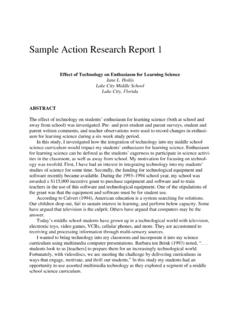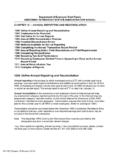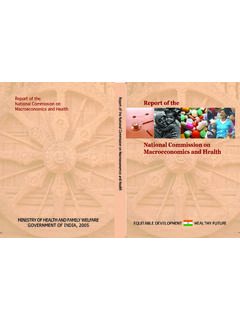Transcription of ACTION RESEARCH REPORT ON SUBHASH …
1 ACTION RESEARCH REPORT ON SUBHASH . palekar 'S ZERO BUDGET NATURAL FARMING. - By Babu*. 1. Introduction Our country has been endowed with rich biodiversity, varied types of soil, copious rainfall and abundant sunshine. This immense natural wealth facilitates cultivation of diverse agricultural crops across the length and breadth of the country. During the long period of cultivation of agricultural crops which dates back to the earliest days of civilization, a system of conventional farming based on innate wisdom and experience was practiced until about the period of independence. Since the size of population was less at that time, farming was not aimed at maximizing agricultural production. A system of natural farming which provided for replenishment of soil nutrients and natural regeneration was followed. The package of agricultural practices did not pose any threat to the stability of the ecosystem and the production was also by and large sufficient to meet the requirements of the population.
2 The infamous Bengal Famine of 1943 severely jolted the food security of our country. An estimated four million people perished because of starvation during the Bengal Famine. The population of the country particularly after independence was also increasing at rapid rate. The paucity of food grain stocks to feed the growing population was amply clear. Deaths due to hunger and starvation were reported from across the country at alarming regularity. The Government was constrained to seek food aid from other countries particularly from USA under PL 480 scheme to stave off hunger and starvation. In this context increasing the food grain production assumed paramount importance and efforts which were stepped up in this direction culminated in the Green Revolution. 2. Green Revolution The advent of Green Revolution in the latter half of 1960s heralded a new era in the history of Indian agriculture.
3 The Green Revolution technology aimed at stimulating agriculture production primarily by replacing traditional hardy varieties of crops by high response varieties and hybrids, increasing the use of fertilizers and plant protection chemicals, bringing more cultivated area under irrigation particularly by huge investments in major irrigation structures and consolidation of land holdings to make agriculture amenable for mechanization. * Faculty (Agriculture), ANSSIRD, Mysore. The initial stimulus was provided by introduction of dwarf, short duration and high response varieties of wheat developed by Dr. Norman E Borlaug, a Mexican Plant Breeder who was subsequently awarded Nobel Prize for International Peace. The traditional varieties of paddy which used to lodge in response to fertilizer application were replaced by non-lodging, short duration and high response varieties. The new varieties of crops were provided with liberal quantities of nitrogenous, phosphates and potassic fertilizers to enhance the productivity.
4 This is evident from the fact that the current use of NPK nutrients is 95 kg per hectare. The increased application of fertilizers rendered the crops more succulent and vulnerable for attack by varied species of insects and diseases. Hence, the new crops were provided with a constant umbrella of plant protection either as prophylactic or as curative measures. The pesticide consumption in our country which was meager 2330. tons during 1950 increased to 1,98,000 tons during 1997-98. Massive investments were made to erect huge water storage structures to bring more cultivated area under irrigation. Institutional support in the form of credit availability to farmers, public procurement of farmers' produce and minimum support price also provided right conditions for increasing agricultural production. The initial response to these technological innovations was very dramatic and it resulted in quantum jump in agricultural production.
5 The food grain production which was around 50 million tons during 1950 increased to 131 million tons during 1978-79 a year in which green revolution technology was considered to have delivered goods. The yield per unit area of farm land improved by more than 30 % between 1947. and 1979. During subsequent decades food grain production increased consistently despite periodical droughts and surpassed 212 million tons during 2003-04. Our country not only attained a semblance of self sufficiency in food grains but also started exporting food grain to other countries on small scale. In a span of about five decades our country was transformed from a starving nation to a food exporter. This experiment with green revolution technology was acclaimed as highly successful. 3. Present Agriculture Scenario in the Country At present the euphoria that was generated by Green Revolution is on the wane and it is increasingly realized that the whole package of technology has left a trail of adverse effects.
6 In our quest for maximizing agricultural production it appears that we lost sight of adverse impact of green revolution technology on the ecosystem. The increased and often indiscriminate use of fertilizers and pesticides immensely harmed biological activity of the soil rendering it almost lifeless in vast areas. It may be pertinent to mention here that ammunition manufacturing units in USA and Europe were converted to fertilizer and pesticide manufacturing plants after the second world war and the produce dumped in Third World countries. Agent Orange' an extremely poisonous chemical which was used to clear bushes and find the enemy hideouts during the Vietnam War has found its way in to the developing countries in the form of herbicide. Persistent Pesticides which are not easily degradable have entered the food chain posing numerous health hazards. A few insecticides including DDT and BHC which have been totally banned in advanced countries are freely marketed in developing countries.
7 Injudicious application of irrigation water has brought in its wake problems of water logging, salinity and alkalinity in large tracts of command areas. Natural resources like water, soil and forests are being exploited without any concerted ACTION for adequate replenishment. In the words of Bertrand Russell, what we are witnessing is frenzied exploitation' of natural resources and it is good to remember an FAO slogan which says that we have not inherited natural resources from our ancestors but we have borrowed them from the posterity. In this bleak scenario, food grain production has almost hit a plateau in recent years. In any case the production is not commensurate with the increased use of high cost inputs like seeds of hybrid/improved varieties, fertilizers and plant protection chemicals. Agriculture production has tended to remain either stagnant or is declining despite application of high cost inputs in large number of agricultural zones.
8 Agriculture production despite troughs due to drought and aberrant weather conditions showed remarkable resilience but the quantum jump in production is conspicuous by its absence. Experts attribute this stagnation to destruction of soil health due to application of fertilizers and pesticides. Critics of Green Revolution also point out that it was confined to few crops like wheat, paddy and maize and few areas of the country particularly Punjab, Haryana and western Uttar Pradesh. The small and marginal farmers who constitute the bulk of farm families were precluded from this process of development because of their inherent low investment capacity. The revolution also did not spread to rain fed areas where production continues to be low and uncertain due to vagaries of monsoon. The high cost of inputs often compels farmers to take loan from money lenders and non-institutional sources and in the event of crop failure they will be forced in to debt trap.
9 A bumper crop also does not necessarily fetch good price. This problem is often compounded by the provisions of WTO which makes it obligatory on signatory nations to allow unrestricted imports to the tune of 5 percent. This often keeps the market prices depressed much to the detriment of indigenous growers. These reasons have been cited as cause for many farmers committing suicide across the country. Many experts in the field of agriculture have voiced concern that any more efforts to persist with this model of chemical agriculture will only prove counter productive in the long run and cause irreparable damage to soil health and environment. Restoring soil health by reverting to non-chemical agriculture has assumed great importance to attain sustainability in production. In this search for eco friendly and farmer friendly alternate systems of farming, SUBHASH palekar 's Zero Budget Natural Farming is increasingly becoming popular among the farming community.
10 4. SUBHASH palekar 's Zero Budget Natural Farming SUBHASH palekar 's Zero Budget Natural Farming is a unique method of farming which requires absolutely no monetary investment for purchase of key inputs like seeds, fertilizers and plant protection chemicals from the market. The farmer can grow hardy local varieties of crops without application of fertilizers and pesticides. Since it is a zero budget farming no institutional credit would be required and dependence on hired labour is also reduced to bare minimum. All that the system requires is native breed of cattle which is any case forms an integral part of farming families in rural areas. It is claimed that one cow is sufficient to take up this method of farming on thirty acres of land. 5. Salient Features of Zero Budget Natural Farming The salient features of this method of farming are: 1) Zero Budget Farming In this system of farming no monetary investment on the part of farmer is required for purchase of seeds, fertilizers and plant protection chemicals from the market.









